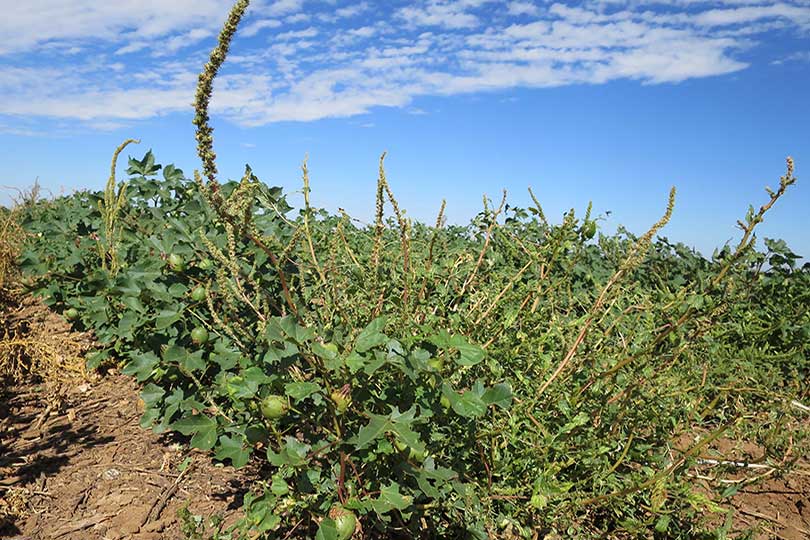By Shala Watson
Multimedia Writer
As farmers prepare for planting season, low commodity prices aren’t the only challenge they face. Farmers across the state are also battling a serious mounting problem—herbicide-resistant weeds.
There are seven weeds listed in Texas as resistant to one herbicide or another, according to Dr. Peter Dotray, AgriLife Extension specialist and weed science professor at Texas Tech University.
Palmer amaranth, also known as pigweed, and waterhemp are two of the main weeds growers are concerned about.
Pigweed is a concern for growers in the Corpus Christi area and northward, as well as in the High Plains. Waterhemp is found closer to Houston and Central Texas.
Roundup Ready technology is no longer as effective in the battle against these weeds.
“As growers continued to kind of over-rely on Roundup, we now are seeing resistant populations of both the waterhemp and the palmer amaranth across the state,” Dotray said. “So what used to be a very effective herbicide and a very good cotton germplasm today is just not as effective.”
But there are new tools farmers can use in 2017 to help slow the spread of the herbicide-resistant weeds.
In recent months, the Environmental Protection Agency (EPA) has approved Dow’s Enlist system and Monsanto’s Xtend systems, using new formulations of dicamba and 2,4-D on cotton plants. The EPA also approved registration for BASF’s Engenia in late 2016 to help farmers control herbicide-resistant weeds.
Farmers in 34 states, including Texas, will now be allowed to use Enlist Duo on corn, soybeans and cotton.
“New technologies are exciting, even though dicamba has been around since the 1950s, and 2,4-D has been around since the 1940s,” Dotray said. “But we’ve never been able to use them in a cotton-growing season. It’s only because of the improved germplasm that allows us to use it.”
But experts urge famers to use the new technology with caution and stress the importance of following label directions to avoid drift accidents and eventually leading to the same issue with Roundup.
“We know, given enough time and enough repeated applications, that the weeds are going to become resistant to those herbicides as well,” Dr. Josh McGinty, Texas A&M AgriLife Extension agronomist in Corpus Christi, said.
Overuse is not as big as a concern as misuse of the new technology.
“I think this is an exciting time for some new technology to help us control our weeds,” Dotray said. “It’s also a time of concern, because we’re dealing with the potential of some misapplications that can be extremely harmful.”
Cotton and soybeans are sensitive to 2,4-D, so spray drift is an issue.
“If we don’t do this right, this is a big black eye on agriculture,” Dotray said. “It is my hope that folks who choose to use it are going to be very respectful of the technology. They are going to use it as they should.”
McGinty said accidents last year with illegal dicamba in the mid-South drove the two-year label registration on these herbicides.
“At the end of that two-year period, EPA is likely going to reevaluate how effective the technology has been,” McGinty said. “And if there’s been mass problems, there’s the potential that they will pull the label from these new technologies.”
The labels on these herbicides are restrictive and the language will be unfamiliar to many farmers, Dotray said.
“Specific spray nozzles, specific things that can or can’t be put in the tank like other surfactants,” Dotray said. “They’re going to need to be very careful with wind speed and the direction the wind is blowing towards susceptible plants and susceptible habitats.”
A good resource farmers can use to help ensure they apply these new technologies correctly can be found in the Texas Row Crop newsletter. Farmers can enter their email address and sign up at www.agriLife.org/TexasRowCrops. The February newsletter will outline applications and best management practices for herbicides.
The information will be updated as requirements change.
Another tool to assist farmers to identify herbicide-resistant fields is “Flag the Technology” by putting a flag at the entry point of any field. Each flag represents a different technology so the app

